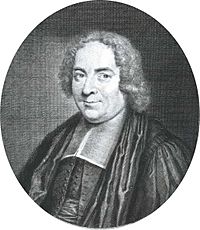Pierre Varignon facts for kids
Quick facts for kids
Pierre Varignon
|
|
|---|---|
 |
|
| Born | 1654 |
| Died | 23 December 1722 Paris, France
|
| Nationality | French |
| Known for | statics, mechanics, infinitesimal calculus, convergence of series, water clock, mechanical explanation of gravitation, Varignon's theorem |
| Scientific career | |
| Fields | Mathematics |
| Institutions | Académie Royale des Sciences, Collège Royal, Collège Mazarin, Berlin Academy, Royal Society |
| Doctoral advisor | Nicolas Malebranche |
| Doctoral students | Jacques Cassini |
Pierre Varignon (born in 1654, died in 1722) was a brilliant French mathematician. He made important discoveries in how things move and balance. He also helped others understand new ideas in math, like calculus.
Contents
Early Life and Education
Pierre Varignon was born in Caen, France, in 1654. He first studied at a Jesuit College. Later, he attended the University of Caen. He earned his Master of Arts degree there in 1682. The next year, he became a priest.
Varignon learned mathematics by reading books by famous thinkers. He studied the works of Euclid, who wrote about geometry. He also read La Géométrie by René Descartes. These books helped him start his journey in mathematics.
Becoming a Professor
In 1688, Varignon became a math professor. He taught at the Collège Mazarin in Paris. In the same year, he joined the Académie Royale des Sciences. This was a very important group of scientists.
He continued to gain recognition for his work. By 1704, he was leading the math department at Collège Mazarin. He also became a professor at the Collège Royal. His fame spread beyond France. He was elected to the Berlin Academy in 1713. In 1718, he joined the Royal Society in London.
Important Friends and Colleagues
Varignon was friends with many famous scientists. These included Isaac Newton and Gottfried Leibniz. He also knew members of the Bernoulli family, who were also great mathematicians. These friendships helped him share and develop new ideas.
Contributions to Mathematics and Physics
Varignon made big contributions to statics and mechanics. These are parts of physics that study forces and motion. He helped simplify many ideas about how things move.
Understanding Calculus
Varignon was one of the first French scientists to support infinitesimal calculus. This is a type of math that deals with very small changes. He defended it against critics like Michel Rolle. Varignon also tried to find a way to test if a series of numbers would "converge." This means if the numbers would add up to a specific value.
Applying Calculus to Motion
He used Leibniz's calculus to explain Newton's ideas about motion. Newton's ideas were in his famous book, Principia. Varignon showed how forces combine to affect movement. He wrote about this in his 1687 work, Projet d'une nouvelle mécanique.
Other Inventions and Ideas
Varignon also worked on many other interesting projects. In 1699, he wrote about how calculus could be used to understand how fluids flow. This included how water clocks work. In 1690, he created a way to explain gravity using mechanics. He also applied calculus to clocks powered by springs in 1702. In 1704, he invented a special U-shaped tube. This device, called a manometer, could measure how thin gases were.
Legacy
Many of Varignon's writings were published after he died. His lectures from Collège Mazarin were put into a book in 1731. His work helped future mathematicians and scientists.
See also
- Varignon's theorem
- Varignon's theorem (mechanics)
- List of Roman Catholic scientist-clerics
Images for kids


